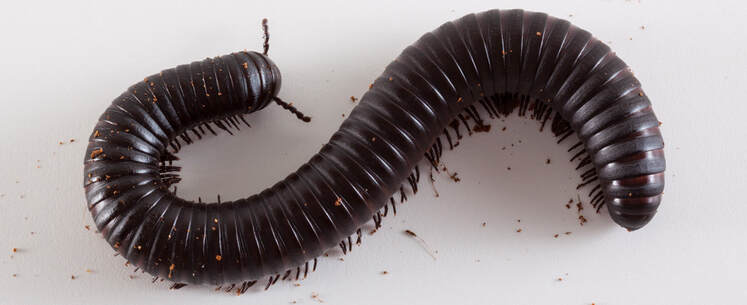African Giant Millipede (Archispirostreptus gigas)
PHYSICAL DESCRIPTION: The African Giant Millipede can grow up to 15 inches long and they have a rounded dark brown or black exoskeleton. As adults they have 30 to 40 body segments. Their total number of legs can vary between molts, as they can grow extra segments during each molt.
Millipedes have four legs per body segment. They have two antennae, and two simple eyes but their eyesight is poor, and they rely on their antenna to navigate. They can smell and taste with most of their body. They move slowly with their legs making a wavelike motion.
RANGE: They can be found in western Africa, in locations like Kenya, Mozambique, South Africa, and Tanzania.
HABITAT: They live on the forest floors, where they can hide among the woody debris. They prefer to hide in warm, humid, dark burrows.
DIET: The African Giant Millipede is a detritivore. They will eat decomposing plant material on the forest floor.
Social Structure: Females lay hundreds of fertilized eggs in hollow nests they burrow under the surface of the soil. The eggs are protected by a tough outer layer and hatch roughly three months after being laid. There is no parental care.
LIFE SPAN: 5 to 7 years in the wild; 10 years in human care
STATUS: Least Concern
Other: African Giant Millipedes have a few defense mechanisms to help protect them from becoming someone else’s tasty snack. First, the millipede can curl into a tightly coiled ball. Its exoskeleton is made up of calcareous dorsal plates that act as body armor, and when paired with the “duck and cover” coiled method, it can help protect the millipede from being picked up and carried away. Second, the millipede secretes a fluid (called repungnatorial fluid) from each body segment that smells and tastes foul to potential predators. This concoction deters the predators and causes them to think twice about eating a millipede for a meal.
Millipedes have four legs per body segment. They have two antennae, and two simple eyes but their eyesight is poor, and they rely on their antenna to navigate. They can smell and taste with most of their body. They move slowly with their legs making a wavelike motion.
RANGE: They can be found in western Africa, in locations like Kenya, Mozambique, South Africa, and Tanzania.
HABITAT: They live on the forest floors, where they can hide among the woody debris. They prefer to hide in warm, humid, dark burrows.
DIET: The African Giant Millipede is a detritivore. They will eat decomposing plant material on the forest floor.
Social Structure: Females lay hundreds of fertilized eggs in hollow nests they burrow under the surface of the soil. The eggs are protected by a tough outer layer and hatch roughly three months after being laid. There is no parental care.
LIFE SPAN: 5 to 7 years in the wild; 10 years in human care
STATUS: Least Concern
Other: African Giant Millipedes have a few defense mechanisms to help protect them from becoming someone else’s tasty snack. First, the millipede can curl into a tightly coiled ball. Its exoskeleton is made up of calcareous dorsal plates that act as body armor, and when paired with the “duck and cover” coiled method, it can help protect the millipede from being picked up and carried away. Second, the millipede secretes a fluid (called repungnatorial fluid) from each body segment that smells and tastes foul to potential predators. This concoction deters the predators and causes them to think twice about eating a millipede for a meal.







